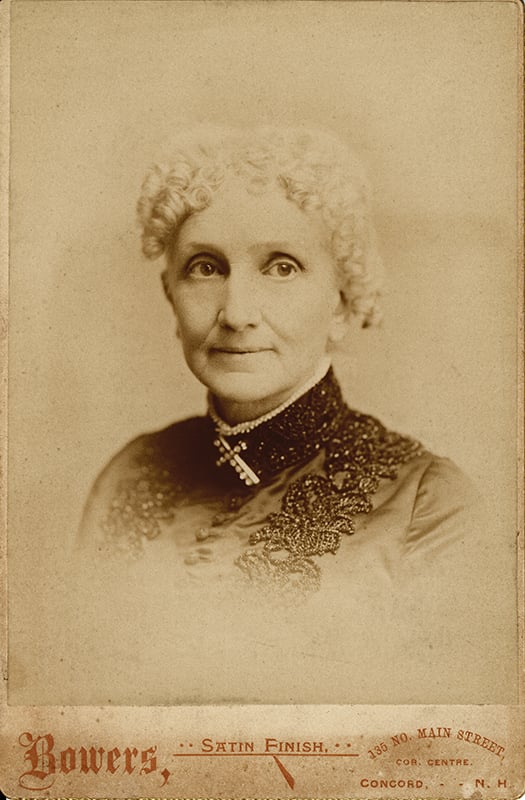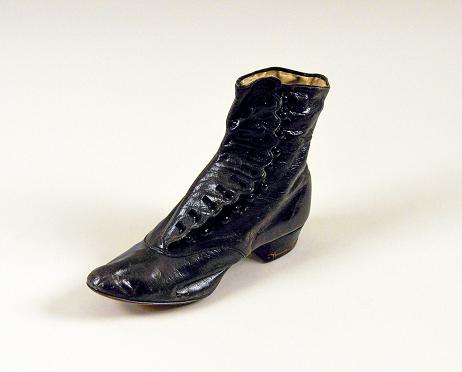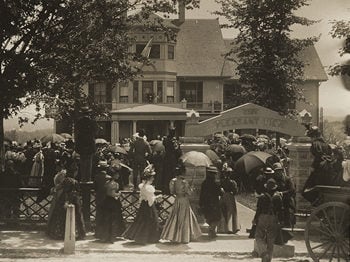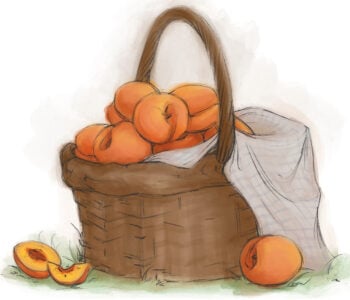
In observance of Women’s History Month, celebrated every year during the month of March, we are sharing an article which describes a small but notable event that took place in Concord, New Hampshire, when Mrs. Eddy was a resident of that city.
The article was first published on December 28, 1950, in The Hampton Union and Rockingham County Gazette (Hampton, New Hampshire) in James Tucker’s “Our Town” column, and was titled “Mary Baker Eddy’s New Shoes.” In it Mr. Tucker gives us his first hand recollection of being employed by W. E. Thompson’s shoe store in Concord, New Hampshire, when elaborate preparations were being made for a visit to the store by Mrs. Eddy, one of Concord’s most famous and highly regarded citizens.
We are struck by the insight we get today into this incident — one of those minute, almost forgotten moments of history — that becomes a significant piece of evidence testifying to the esteem in which Mary Baker Eddy, the Discoverer, Founder, and already established Leader of the Christian Science movement, was held by her fellow citizens of Concord.
We are printing the article in its entirety with permission.
NEW SHOES FOR MARY BAKER EDDY
One never knows his exact destination when he boards a “train of thoughts.” For instance, we were thinking about the poet Whittier and ended up with Mary Baker Eddy’s new shoes. It was this way: Whittier seemed like an ideal subject for an “Our Town” column. He had written many poems which related to Hampton. One of these poems had to do with General Moulton. The Moulton house is one of the finest examples of early American architecture and a Hampton landmark. It was rehabilitated by its present owner, Mr. Harlan G. Little. Before he retired, Mr. Little manufactured Sorosis shoes for women. William Thompson of Concord, sold Sorosis shoes many years ago at retail.
Mary Baker Eddy, the founder and head of Christian Science, was one of his customers. Her shoes were made to order on a special last and they were very small — size 2 AA, if I remember correctly — and they were very pretty. One day, Mrs. Eddy paid Mr. Thompson a very special compliment. Her secretary, Mr. Calvin Frye, telephoned that she would come into the North Main Street store to try on a new pair of shoes that had just been received from the manufacturer. It turned out to be a very special event. We know, because we were in Mr. Thompson’s employ at the time and we helped to arrange the interesting details of that unusual visit. So, that’s how we started a train of thoughts with the poet Whittier and ended up with Mary Baker Eddy’s new shoes.
Mary Baker G. Eddy lived for some years in Amesbury. She probably visited Hampton Beach on many occasions. She may have been as impressed as Whittier was with our town. However, many important years of that great woman’s life were spent at her Concord home, “Pleasant View.” As a working newspaper man in Concord, a native and a resident of the Capital City for forty years, we had many opportunities to observe Mrs. Eddy and were well acquainted with her personal attorney, Mr. Frank Streeter. She was indeed a remarkable woman. But we were just out of High School when the interesting episode of the new shoes occurred.

In the early 1900’s, William E. Thompson had one of the largest retail shoe stores in New Hampshire. Previous to graduating from High School in 1904 we had been employed by the Thompson firm at such hours during the week as did not interfere with school hours. After graduating we were permanently employed there for over a year before entering college. It was sometime during this period that Mr. Thompson got the unusual message from Mr. Frye that on a certain afternoon of that week, around two o’clock, Mrs. Eddy would be in to try on her new shoes. Now, except for an occasional visit to Derby’s Jewelry Store, Mrs. Eddy never entered Concord business places, although she patronized many of them generously. William Thompson, conscious of the unusual honor which the gracious lady was paying him, began immediately to make unique preparations for her visit.
All of the store woodwork was scrubbed and polished. The floors were washed, up stairs and down. Every one of the thousands of shoeboxes was dusted and rearranged meticulously on the shelves. The show-windows were thoroughly cleaned and redecorated. But particular attention was paid to the ten foot square office which had been partitioned off for Mr. Thompson’s private use with nine foot high siding in one corner of the back of the store.
A roll-topped oak desk and chair —about the only articles of furniture in the place — were polished and an accumulated litter of newspapers, trade magazines, shoe lasts and samples were cleaned out completely. For, in this sanctum sanctorum, Mr. Thompson would try on Mrs. Eddy’s new shoes. The entire emporium, including the office and the basement where lumbermen’s shoes, felts and rubbers were sold, was made spick and span.
On the morning before the visit of this world famous woman, Mr. Thompson and the oversigned visited Norris Dundee’s Livery Stable on Pleasant Street, now the site of the Star Theatre. We went into the tack room and came out with our arms filled to overflowing with the multicolored, fluffy mats which were used in those bygone days to cover the floors of buggys, carryalls and other types of horse drawn vehicles. These were used — and this is a true story — to cover the floor of Mr. Thompson’s private office.

An express team brought a few pieces of horsehair furniture from the front parlor of Julia Bolger’s home and these were carefully placed on the gaudy mats that covered the office floor. Julia was the cashier and bookkeeper of the Thompson firm and like all of the other employees, she was glad to help out the boss on this auspicious occasion. One of Julia’s best pieces, a low seated, high back chair, was placed in the middle of one side of the office opposite the roll-top desk. Sofa pillows, also loaned by Miss Bolger, were placed on the chair seat and against the chair back to assure maximum comfort for Mrs. Eddy.
When we left for home that night at the end of a particularly grueling day, Mr. Thompson told all of us, clerks, bookkeepers and the colored shoeshine boy, that we must wear our “Sunday clothes” to work the next day. So, the next morning we all came to work dressed in our Sunday best. Mr. Thompson wore a frock coat with striped gray trousers and carried a bouquet of two dozen carnations which he carefully placed in a vase on top of his oak desk. Lunchtime came and passed quickly and at two o’clock we were all at the special places which had been assigned to us along the counters on either side of the big store.
Promptly, as the bell in the Town Clock at the corner of School Street chimed the hour of two, the Eddy coach drawn by a beautiful pair of matched bays, was driven to the edge of the sidewalk opposite the store entrance. Mr. Calvin Frye climbed down from the coachman’s box where he sat beside the driver, and opened the carriage door. He offered his arm to the tall, stately lady with the beautiful, serene countenance and they were met at the door by Mr. Thompson. The boss bowed low and remarked concerning the high honor which Mrs. Eddy had conferred on him by coming personally to his store. The proprietor escorted his visitors to his private office and closed the door.
We have wondered a thousand times since what that good woman must have thought as she entered that strangely decorated office and seated herself on the becushioned, horsehair chair, arranged like a low throne in the center of one side of the little room. We know not what her thoughts were but of one thing we can be absolutely certain. Her composed, regal-like demeanor was not in the least changed although she most certainly must have been amused by her incongruous surroundings and perhaps touched by the obvious attempt to provide for her an entirely suitable place in which to try on her new shoes.
In a half hour the door opened and out came Mrs. Eddy, again on the arm of Mr. Frye. Now, she was holding in her left hand, the stems dripping water, the bouquet of carnations which Mr. Thompson had plucked from the vase and thrust into her hand. But if she was in the least perturbed or embarrassed she certainly did not show it, for her really beautiful face broke into a kind smile and she nodded pleasantly to each of us as she passed by our appointed stations on her way back to the entrance door.
And so, Mrs. Eddy tried on her new, satin-lined high kid shoes with her initials “M. B. G. E.” embroidered in silk on the lining. And they must have fitted perfectly for on the next day they were sent to “Pleasant View” by special messenger.
EDITORIAL NOTE: In the third paragraph of Mr. Tucker’s article, he mentions that Mrs. Eddy lived in Amesbury, Massachusetts. This is true; she resided there in parts of 1868 and 1870. He also says “She probably visited Hampton Beach on many occasions.” We feel we must add that it is not known when, or if, she ever visited Hampton Beach!







